Weiquan Huang
LLM2CLIP: Powerful Language Model Unlocks Richer Visual Representation
Nov 26, 2024



Abstract:CLIP is a foundational multimodal model that aligns image and text features into a shared space using contrastive learning on large-scale image-text pairs. Its strength lies in leveraging natural language as a rich supervisory signal. With the rapid progress of large language models (LLMs), we explore their potential to further enhance CLIP's multimodal representation learning. This work introduces a fine-tuning approach that integrates LLMs with the pretrained CLIP visual encoder, leveraging LLMs' advanced text understanding and open-world knowledge to improve CLIP's ability to process long and complex captions. To address the challenge of LLMs' autoregressive nature, we propose a caption-to-caption contrastive learning framework to enhance the discriminative power of their outputs. Our method achieves substantial performance gains on various downstream tasks, demonstrating the effectiveness of combining LLMs with CLIP for enhanced multimodal learning.
LLM2CLIP: Powerful Language Model Unlock Richer Visual Representation
Nov 07, 2024



Abstract:CLIP is one of the most important multimodal foundational models today. What powers CLIP's capabilities? The rich supervision signals provided by natural language, the carrier of human knowledge, shape a powerful cross-modal representation space. However, with the rapid advancements in large language models LLMs like GPT-4 and LLaMA, the boundaries of language comprehension and generation are continually being pushed. This raises an intriguing question: can the capabilities of LLMs be harnessed to further improve multimodal representation learning? The potential benefits of incorporating LLMs into CLIP are clear. LLMs' strong textual understanding can fundamentally improve CLIP's ability to handle image captions, drastically enhancing its ability to process long and complex texts, a well-known limitation of vanilla CLIP. Moreover, LLMs are trained on a vast corpus of text, possessing open-world knowledge. This allows them to expand on caption information during training, increasing the efficiency of the learning process. In this paper, we propose LLM2CLIP, a novel approach that embraces the power of LLMs to unlock CLIP's potential. By fine-tuning the LLM in the caption space with contrastive learning, we extract its textual capabilities into the output embeddings, significantly improving the output layer's textual discriminability. We then design an efficient training process where the fine-tuned LLM acts as a powerful teacher for CLIP's visual encoder. Thanks to the LLM's presence, we can now incorporate longer and more complex captions without being restricted by vanilla CLIP's text encoder's context window and ability limitations. Our experiments demonstrate that this approach brings substantial improvements in cross-modal tasks.
Segment-Anything Models Achieve Zero-shot Robustness in Autonomous Driving
Aug 19, 2024



Abstract:Semantic segmentation is a significant perception task in autonomous driving. It suffers from the risks of adversarial examples. In the past few years, deep learning has gradually transitioned from convolutional neural network (CNN) models with a relatively small number of parameters to foundation models with a huge number of parameters. The segment-anything model (SAM) is a generalized image segmentation framework that is capable of handling various types of images and is able to recognize and segment arbitrary objects in an image without the need to train on a specific object. It is a unified model that can handle diverse downstream tasks, including semantic segmentation, object detection, and tracking. In the task of semantic segmentation for autonomous driving, it is significant to study the zero-shot adversarial robustness of SAM. Therefore, we deliver a systematic empirical study on the robustness of SAM without additional training. Based on the experimental results, the zero-shot adversarial robustness of the SAM under the black-box corruptions and white-box adversarial attacks is acceptable, even without the need for additional training. The finding of this study is insightful in that the gigantic model parameters and huge amounts of training data lead to the phenomenon of emergence, which builds a guarantee of adversarial robustness. SAM is a vision foundation model that can be regarded as an early prototype of an artificial general intelligence (AGI) pipeline. In such a pipeline, a unified model can handle diverse tasks. Therefore, this research not only inspects the impact of vision foundation models on safe autonomous driving but also provides a perspective on developing trustworthy AGI. The code is available at: https://github.com/momo1986/robust_sam_iv.
CLIP-Mamba: CLIP Pretrained Mamba Models with OOD and Hessian Evaluation
Apr 30, 2024Abstract:State space models and Mamba-based models have been increasingly applied across various domains, achieving state-of-the-art performance. This technical report introduces the first attempt to train a transferable Mamba model utilizing contrastive language-image pretraining (CLIP). We have trained Mamba models of varying sizes and undertaken comprehensive evaluations of these models on 26 zero-shot classification datasets and 16 out-of-distribution (OOD) datasets. Our findings reveal that a Mamba model with 67 million parameters is on par with a 307 million-parameter Vision Transformer (ViT) model in zero-shot classification tasks, highlighting the parameter efficiency of Mamba models. In tests of OOD generalization, Mamba-based models exhibit exceptional performance in conditions of OOD image contrast or when subjected to high-pass filtering. However, a Hessian analysis indicates that Mamba models feature a sharper and more non-convex landscape compared to ViT-based models, making them more challenging to train. The source code is available at https://github.com/raytrun/mamba-clip.
Benchmarking Chinese Commonsense Reasoning of LLMs: From Chinese-Specifics to Reasoning-Memorization Correlations
Mar 21, 2024Abstract:We introduce CHARM, the first benchmark for comprehensively and in-depth evaluating the commonsense reasoning ability of large language models (LLMs) in Chinese, which covers both globally known and Chinese-specific commonsense. We evaluated 7 English and 12 Chinese-oriented LLMs on CHARM, employing 5 representative prompt strategies for improving LLMs' reasoning ability, such as Chain-of-Thought. Our findings indicate that the LLM's language orientation and the task's domain influence the effectiveness of the prompt strategy, which enriches previous research findings. We built closely-interconnected reasoning and memorization tasks, and found that some LLMs struggle with memorizing Chinese commonsense, affecting their reasoning ability, while others show differences in reasoning despite similar memorization performance. We also evaluated the LLMs' memorization-independent reasoning abilities and analyzed the typical errors. Our study precisely identified the LLMs' strengths and weaknesses, providing the clear direction for optimization. It can also serve as a reference for studies in other fields. We will release CHARM at https://github.com/opendatalab/CHARM .
Attentive Mask CLIP
Dec 16, 2022



Abstract:Image token removal is an efficient augmentation strategy for reducing the cost of computing image features. However, this efficient augmentation strategy has been found to adversely affect the accuracy of CLIP-based training. We hypothesize that removing a large portion of image tokens may improperly discard the semantic content associated with a given text description, thus constituting an incorrect pairing target in CLIP training. To address this issue, we propose an attentive token removal approach for CLIP training, which retains tokens with a high semantic correlation to the text description. The correlation scores are computed in an online fashion using the EMA version of the visual encoder. Our experiments show that the proposed attentive masking approach performs better than the previous method of random token removal for CLIP training. The approach also makes it efficient to apply multiple augmentation views to the image, as well as introducing instance contrastive learning tasks between these views into the CLIP framework. Compared to other CLIP improvements that combine different pre-training targets such as SLIP and MaskCLIP, our method is not only more effective, but also much more efficient. Specifically, using ViT-B and YFCC-15M dataset, our approach achieves $43.9\%$ top-1 accuracy on ImageNet-1K zero-shot classification, as well as $62.7/42.1$ and $38.0/23.2$ I2T/T2I retrieval accuracy on Flickr30K and MS COCO, which are $+1.1\%$, $+5.5/+0.9$, and $+4.4/+1.3$ higher than the SLIP method, while being $2.30\times$ faster. An efficient version of our approach running $1.16\times$ faster than the plain CLIP model achieves significant gains of $+5.3\%$, $+11.3/+8.0$, and $+9.5/+4.9$ on these benchmarks.
Causal Information Bottleneck Boosts Adversarial Robustness of Deep Neural Network
Oct 25, 2022



Abstract:The information bottleneck (IB) method is a feasible defense solution against adversarial attacks in deep learning. However, this method suffers from the spurious correlation, which leads to the limitation of its further improvement of adversarial robustness. In this paper, we incorporate the causal inference into the IB framework to alleviate such a problem. Specifically, we divide the features obtained by the IB method into robust features (content information) and non-robust features (style information) via the instrumental variables to estimate the causal effects. With the utilization of such a framework, the influence of non-robust features could be mitigated to strengthen the adversarial robustness. We make an analysis of the effectiveness of our proposed method. The extensive experiments in MNIST, FashionMNIST, and CIFAR-10 show that our method exhibits the considerable robustness against multiple adversarial attacks. Our code would be released.
Trusted Multi-Scale Classification Framework for Whole Slide Image
Jul 12, 2022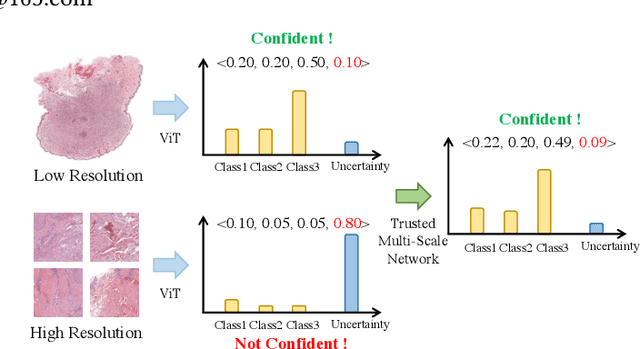

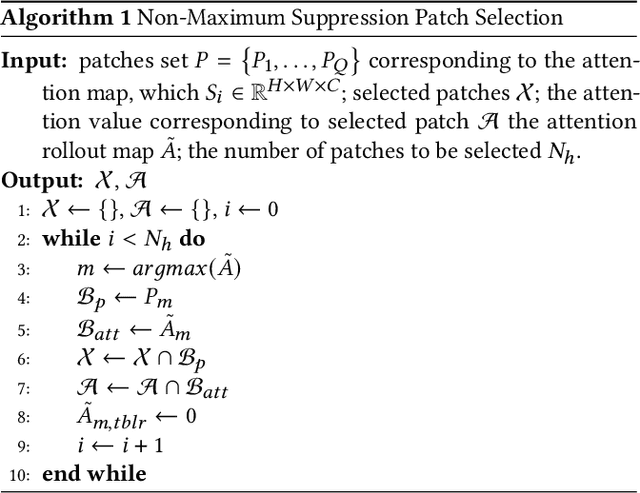
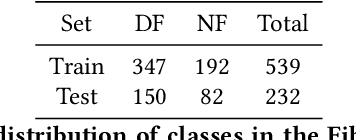
Abstract:Despite remarkable efforts been made, the classification of gigapixels whole-slide image (WSI) is severely restrained from either the constrained computing resources for the whole slides, or limited utilizing of the knowledge from different scales. Moreover, most of the previous attempts lacked of the ability of uncertainty estimation. Generally, the pathologists often jointly analyze WSI from the different magnifications. If the pathologists are uncertain by using single magnification, then they will change the magnification repeatedly to discover various features of the tissues. Motivated by the diagnose process of the pathologists, in this paper, we propose a trusted multi-scale classification framework for the WSI. Leveraging the Vision Transformer as the backbone for multi branches, our framework can jointly classification modeling, estimating the uncertainty of each magnification of a microscope and integrate the evidence from different magnification. Moreover, to exploit discriminative patches from WSIs and reduce the requirement for computation resources, we propose a novel patch selection schema using attention rollout and non-maximum suppression. To empirically investigate the effectiveness of our approach, empirical experiments are conducted on our WSI classification tasks, using two benchmark databases. The obtained results suggest that the trusted framework can significantly improve the WSI classification performance compared with the state-of-the-art methods.
Large-Scale Unsupervised Person Re-Identification with Contrastive Learning
May 17, 2021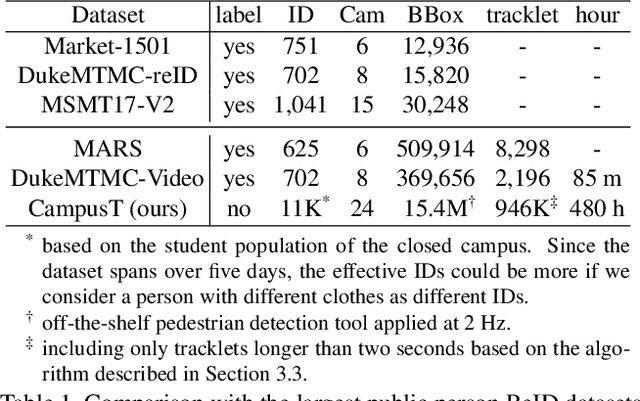
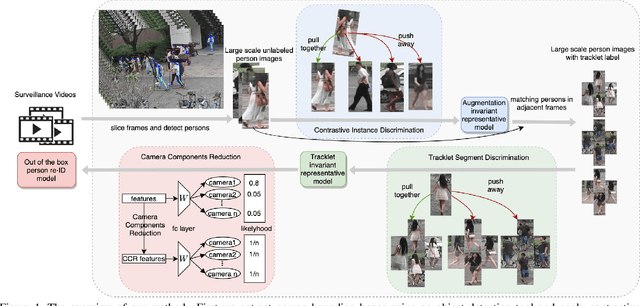
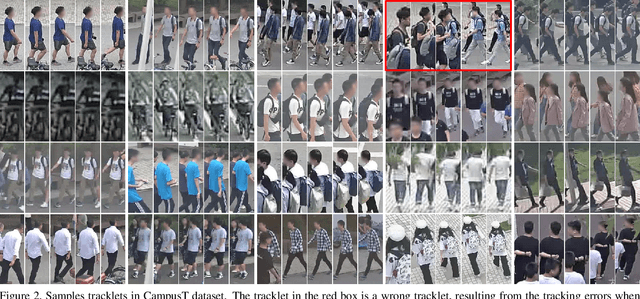

Abstract:Existing public person Re-Identification~(ReID) datasets are small in modern terms because of labeling difficulty. Although unlabeled surveillance video is abundant and relatively easy to obtain, it is unclear how to leverage these footage to learn meaningful ReID representations. In particular, most existing unsupervised and domain adaptation ReID methods utilize only the public datasets in their experiments, with labels removed. In addition, due to small data sizes, these methods usually rely on fine tuning by the unlabeled training data in the testing domain to achieve good performance. Inspired by the recent progress of large-scale self-supervised image classification using contrastive learning, we propose to learn ReID representation from large-scale unlabeled surveillance video alone. Assisted by off-the-shelf pedestrian detection tools, we apply the contrastive loss at both the image and the tracklet levels. Together with a principal component analysis step using camera labels freely available, our evaluation using a large-scale unlabeled dataset shows far superior performance among unsupervised methods that do not use any training data in the testing domain. Furthermore, the accuracy improves with the data size and therefore our method has great potential with even larger and more diversified datasets.
 Add to Chrome
Add to Chrome Add to Firefox
Add to Firefox Add to Edge
Add to Edge